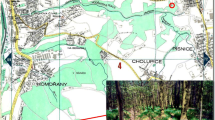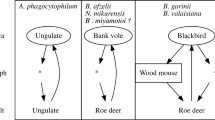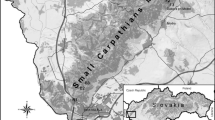Abstract
The vertical distribution in the vegetation of questing Ixodes ricinus ticks was investigated in two different vegetation types (‘high’ and ‘low’ vegetation) at two localities in south-central Sweden during 1992-1993 (Toro) and 1995 (Bogesund). Significant correlations were found between the vertical distribution of immature ticks and the height of the vegetation. The greatest mean availabilities of the larvae and nymphs in low vegetation were in the intervals 0-9 and 30-39 cm, respectively. The larval numbers were greatest close to the ground (0-29 cm) in both high and low vegetation. The larval : nymphal ratio, at ground level at localities free of ground vegetation, varied between 8 : 1 and 32 : 1. In high vegetation, the greatest mean numbers of nymphal and adult ticks were at height intervals of 50-59 and 60-79 cm, respectively. These ranges are within the estimated height interval (40-100 cm) of the main part of the body surface of their ‘preferred’ host, the roe deer (Capreolus capreolus). The presence of most questing I. ricinus larvae at ground level would favour the transmission of Borrelia burgdorferi s.l., since this is where the highly reservoir-competent rodents and shrews usually occur.
Similar content being viewed by others
REFERENCES
Belozerov, V.N. 1982. Diapause and biological rhythms in ticks. In Physiology of ticks, F.D. Obenchain and R. Galun (eds), pp. 469–500. Pergamon Press, New York.
Gigon, F. 1985. Biologie d'Ixodes ricinus L. sur le Plateau Suisse — une contribution à l'écologie de ce vecteur. Doctoral thesis, Faculty of Sciences, University of Neuchâtel.
Lees, A.D. 1948. The sensory physiology of the sheep tick Ixodes ricinus L. J. Exp. Biol. 25: 145–207.
Lees, A.D. and Milne, A. 1951. The seasonal and diurnal activities of individual sheep ticks (Ixodes ricinus L.). Parasitology 41: 189–208.
Loye, J.E. and Lane, R.S. 1988. Questing behavior of Ixodes pacificus (Acari: Ixodidae) in relation to meteorological and seasonal factors. J. Med. Entomol. 25: 391–398.
Sokal, R.R. and Rohlf, F.J. 1981. Biometry, 2 edn. W.H. Freeman and Co, New York.
Tälleklint, L. and Jaenson, T.G.T. 1994. Transmission of Borrelia burgdorferi s.l. from mammal reservoirs to the primary vector of Lyme borreliosis, Ixodes ricinus (Acari: Ixodidae), in Sweden. J. Med. Entomol. 31: 880–886.
Author information
Authors and Affiliations
Rights and permissions
About this article
Cite this article
Mejlon, H., Jaenson, T. Questing behaviour of Ixodes ricinus ticks (Acari: Ixodidae). Exp Appl Acarol 21, 747–754 (1997). https://doi.org/10.1023/A:1018421105231
Issue Date:
DOI: https://doi.org/10.1023/A:1018421105231




